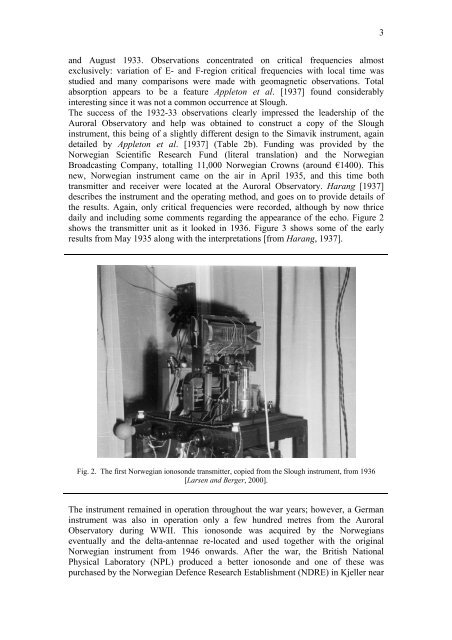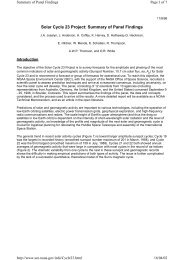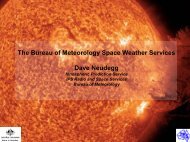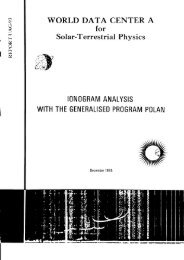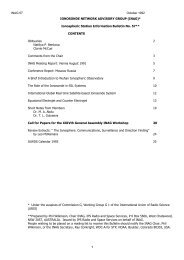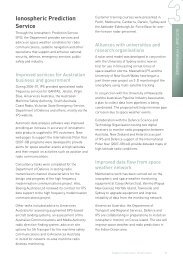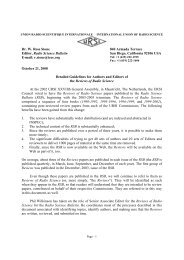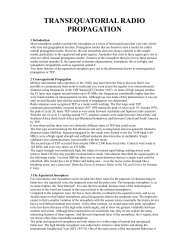20th Century operation of the Tromsø Ionosonde - IPS - Radio and ...
20th Century operation of the Tromsø Ionosonde - IPS - Radio and ...
20th Century operation of the Tromsø Ionosonde - IPS - Radio and ...
You also want an ePaper? Increase the reach of your titles
YUMPU automatically turns print PDFs into web optimized ePapers that Google loves.
<strong>and</strong> August 1933. Observations concentrated on critical frequencies almost<br />
exclusively: variation <strong>of</strong> E- <strong>and</strong> F-region critical frequencies with local time was<br />
studied <strong>and</strong> many comparisons were made with geomagnetic observations. Total<br />
absorption appears to be a feature Appleton et al. [1937] found considerably<br />
interesting since it was not a common occurrence at Slough.<br />
The success <strong>of</strong> <strong>the</strong> 1932-33 observations clearly impressed <strong>the</strong> leadership <strong>of</strong> <strong>the</strong><br />
Auroral Observatory <strong>and</strong> help was obtained to construct a copy <strong>of</strong> <strong>the</strong> Slough<br />
instrument, this being <strong>of</strong> a slightly different design to <strong>the</strong> Simavik instrument, again<br />
detailed by Appleton et al. [1937] (Table 2b). Funding was provided by <strong>the</strong><br />
Norwegian Scientific Research Fund (literal translation) <strong>and</strong> <strong>the</strong> Norwegian<br />
Broadcasting Company, totalling 11,000 Norwegian Crowns (around €1400). This<br />
new, Norwegian instrument came on <strong>the</strong> air in April 1935, <strong>and</strong> this time both<br />
transmitter <strong>and</strong> receiver were located at <strong>the</strong> Auroral Observatory. Harang [1937]<br />
describes <strong>the</strong> instrument <strong>and</strong> <strong>the</strong> operating method, <strong>and</strong> goes on to provide details <strong>of</strong><br />
<strong>the</strong> results. Again, only critical frequencies were recorded, although by now thrice<br />
daily <strong>and</strong> including some comments regarding <strong>the</strong> appearance <strong>of</strong> <strong>the</strong> echo. Figure 2<br />
shows <strong>the</strong> transmitter unit as it looked in 1936. Figure 3 shows some <strong>of</strong> <strong>the</strong> early<br />
results from May 1935 along with <strong>the</strong> interpretations [from Harang, 1937].<br />
Fig. 2. The first Norwegian ionosonde transmitter, copied from <strong>the</strong> Slough instrument, from 1936<br />
[Larsen <strong>and</strong> Berger, 2000].<br />
The instrument remained in <strong>operation</strong> throughout <strong>the</strong> war years; however, a German<br />
instrument was also in <strong>operation</strong> only a few hundred metres from <strong>the</strong> Auroral<br />
Observatory during WWII. This ionosonde was acquired by <strong>the</strong> Norwegians<br />
eventually <strong>and</strong> <strong>the</strong> delta-antennae re-located <strong>and</strong> used toge<strong>the</strong>r with <strong>the</strong> original<br />
Norwegian instrument from 1946 onwards. After <strong>the</strong> war, <strong>the</strong> British National<br />
Physical Laboratory (NPL) produced a better ionosonde <strong>and</strong> one <strong>of</strong> <strong>the</strong>se was<br />
purchased by <strong>the</strong> Norwegian Defence Research Establishment (NDRE) in Kjeller near<br />
3


